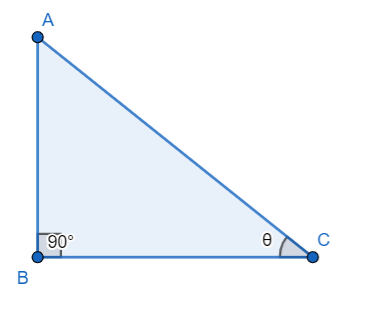Question
Question: How do you prove \[\tan \theta \cot \theta =1\]?...
How do you prove tanθcotθ=1?
Solution
To prove this tanθcotθ=1, we will use a right-angled triangle with one angle θ. In the right angle triangle, we will find the values of tanθ and cotθ with the help of sinθ and cosθ. And then we will simplify it to get the required statement.
Complete step-by-step solution:
In this question, we have been asked to prove that tanθcotθ=1.
For that, let us take a right angle triangle ABC.

In the above right angle triangle ABC, we have considered the right angle at B and ∠C=θ.
So we can say, AB is the perpendicular, BC is the base and AC is the hypotenuse of the right-angled triangle ABC.
Now, we will try to find or calculate sinθ.
In the right angle triangle ABC,
As we know that sinθ is the ratio of the perpendicular to the hypotenuse.
We can mathematically represent it as sinθ=ACAB………(1)
Now, we will try to find or calculate cosθ.
In the right angle triangle ABC,
As we know that cosθ is the ratio of the base to the hypotenuse.
We can mathematically represent it as cosθ=ACBC………..(2)
Now, we will try to find or calculate tanθ.
In the right angle triangle ABC,
As we know that tanθ is the ratio of sinθ to cosθ.
We can mathematically represent it as tanθ=cosθsinθ……….(3)
Now, we will try to find or calculate cotθ.
In the right angle triangle ABC,
As we know that cotθ is the ratio of cosθ to sinθ.
We can mathematically represent it as cotθ=sinθcosθ………….(4)
Now, we will divide equation (1) by equation (2).
⇒cosθsinθ=(ACBC)(ACAB)
And we know that the same terms from numerator and denominator cancel out. Therefore, we get
⇒cosθsinθ=BCAB
From equation (3), we can write
tanθ=BCAB……….(5)
Now, we will take the reciprocal of equation (5).
⇒cosθsinθ1=BCAB1
⇒sinθcosθ=ABBC
But from equation (4), we can say
cotθ=ABBC……………(6)
Now, we will multiply equation (5) by (6).
⇒tanθ⋅cotθ=BCAB⋅ABBC
And we can further simplify it as
⇒tanθ⋅cotθ=1
Hence, we have proved that tanθ⋅cotθ=1
Note: Whenever we get this type of problem, we will try to use the right angle triangle and then use trigonometry. We can also do this problem in one step because tanθ is the reciprocal of cotθ. Also, we need to keep this property in our mind because we might require this property for other questions.
